BY JEFFREY RESSNER
Photographed by Scott Council
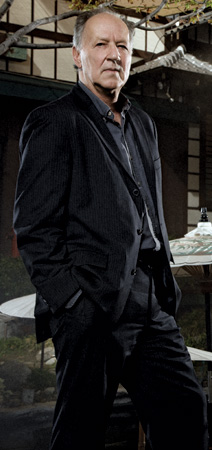 A fever dream of South American natives lugging a 320-ton steamboat over a jungle mountaintop in Peru; a childish nature-boy tussling with killer grizzly bears in the Alaskan wilderness; a Caribbean islander so blasé about an impending volcano blast that he sleeps peacefully in the shadow of its smoking chimney. Iconoclastic filmmaker Werner Herzog has visited all these places and explored the madness behind them.
A fever dream of South American natives lugging a 320-ton steamboat over a jungle mountaintop in Peru; a childish nature-boy tussling with killer grizzly bears in the Alaskan wilderness; a Caribbean islander so blasé about an impending volcano blast that he sleeps peacefully in the shadow of its smoking chimney. Iconoclastic filmmaker Werner Herzog has visited all these places and explored the madness behind them.
His features and documentaries are filled with stark images of man against the elements. But along with the arresting visuals, Herzog's love of poetry and language also plays a major role in his work. He often speaks of attaining an “ecstatic truth” in his movies, which include Aguirre: The Wrath of God, Fitzcarraldo, Encounters at the End of the World and Grizzly Man, for which he won the DGA Award for outstanding directorial achievement in documentary in 2005.
First exposed to American audiences as a member of the German New Wave in the early '70s (to which he claims no affinity), Herzog has directed nearly 60 movies and more than a dozen operas. But he hasn't mellowed with age. In making documentaries, he says, “The director must be the hornet that stings, not the fly on the wall.”
Herzog relocated to Los Angeles with his wife about 10 years ago and now proclaims himself a proud Angeleno. But he is busier than ever these days, flying around the world to shoot movies, hear new stories, arrange financing, appear at festivals, and even teach seminars at the Rogue Film School he started this year. Meeting at the DGA headquarters, his lyricism even comes across in conversation, along with his unwavering and strong opinions about making movies.
JEFFREY RESSNER: In the past you've often described yourself as 'a good soldier of cinema.' What does that mean exactly?
WERNER HERZOG: In part, it means holding an artistic outpost that others have abandoned. It means discipline. It means perseverance. It means courage. For instance, Roger Ebert is a great soldier of cinema, for reasons that are self-evident.
Q: What made you want to become a good soldier of cinema, considering you grew up very isolated in the Bavarian countryside where there wasn't even a movie theater?
A: I had no idea cinema even existed until I was 11 years old. A traveling projectionist showed up at our one-room school in the mountains and showed some very bad documentaries from the United States about Eskimos. They didn't impress me at all. But when I was about 14, I knew I was going to make films, and I knew that also meant being a poet. It was not an attraction—it was irrevocably there. The only thing I had to decide was whether I would shoulder this destiny or not, because I knew it was going to be a complicated life. I knew the films I wanted to make would not find allies or partners.
Q: How did you get the resources to start making movies?
A: I worked the night shift as a welder in a steel factory for over two years in high school to raise money for my first three featurettes, instantly going into 35 mm. I didn't want to fool around or experiment; I worked to get my films into cinemas right away, no matter whether I sold the films or not—which I still haven't done. But that's fine. An accumulation of defeats converted self-dialectically into some sort of accomplishment and a step into real production of films.
Q: How did you know what to do? Did your early efforts come about instinctively, or through trial and error?
A: In a way it was my own film school. The very first film, Herakles, I had a clear idea to connect bodybuilders with the mythological feats of Herakles of antiquity. I had seen material that was utterly fascinating but was incompatible, and so strange that you couldn't explain how to meld them together. Editing! That was the idea. How do I put things together where nobody sees the connection? Today I still do that. For Bad Lieutenant: Port of Call New Orleans, I felt iguanas should be part of the demented fantasy that only the lieutenant [Nicolas Cage] on drugs would notice. It's strange, but everyone who has seen the film mentions that scene. There are elements you can't normally marry together in one image, yet it's a special spirit that occurs in filmmaking and no other form of media.
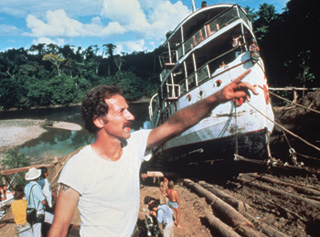 SHIPPING OUT: Herzog directs traffic on the set of Fitzcarraldo. He says the
SHIPPING OUT: Herzog directs traffic on the set of Fitzcarraldo. He says the
audience recognized something familiar, "like finding a long-lost brother,"
in the image of the ship being pulled over the mountain.
Q: You've said Bad Lieutenant is a new step in film noir. Are you a fan of the genre?
A:Yes, I like it a lot. But we shouldn't emphasize the statement too much, because I think now in times of insecurity and financial collapse, it's a very natural consequence to have film noir emerging again. And I didn't want to have the kind of oppressive climate that invades characters in film noir as we know it. I said to Nicolas Cage, let's go for the bliss of evil. Enjoy yourself. As vile and debased as it gets, you have to enjoy yourself in it. And it becomes very hilarious. It is so vile that it's totally hilarious.
Q:In your early films, you frequently worked with unconventional actors, such as the former mental patient Bruno S. in The Enigma of Kaspar Hauser, and in Heart of Glass, you placed much of your cast under hypnosis. Is there any common technique you found useful in directing these actors?
A: The only thing always is: What do you have on the screen at the end of everything? And, of course, in some cases, we have to make bold moves to elicit something extraordinary from a person. This is why the entire cast in Heart of Glass acted under hypnosis. I needed a somnambulistic sort of attitude and climate, something like sleepwalking, a collective trance into which the whole village community lapsed. We should not stop being bold and looking for new ways to achieve something extraordinary.
Q: Did you ever use that hypnosis technique again?
A: No, because it was for one specific film, and one specific stylization. I did not need a stylization like that in [most recently] My Son, My Son, What Have Ye Done. Otherwise it would become a circus gimmick. You see, I'm not out for that. I'm out for real substance.
Q: How do you think your filmmaking is different now from when you were just starting out?
A: Well, I've never stood still. I remember after Even Dwarfs Started Small and Fata Morgana, when I came out with Aguirre: The Wrath of God, almost the entire media and all my friends turned away from me and said, 'Oh, he's gone commercial now!' which at the time was the worst thing you could do. But I've always said that all my films are commercial and I've never felt like a maverick. I'm occupying the center and I'm mainstream, while the others feel bizarre. Although some of them have made hundreds of millions of dollars at the box office, so what? I'm still occupying the center.
Q: When most Americans first heard of you, it was as part of the German New Wave, along with Rainer Werner Fassbinder, Wim Wenders and Volker Schlöndorff. How did you feel being included in this movement?
A: I never felt comfortable, because I was always somehow distant and never felt as though I belonged to some group. But that's okay. After the Nazi barbarism, it took 20-25 years until a new generation grew up and started making films of a different kind. So there was a huge cultural background to this, and I understand it and see a point to it. However, we did not share a common style or causes or subjects as the neorealists in Italy did. We didn't have anything like that, not even close.
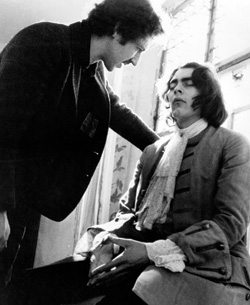 ALTERED STATES: Herzog hypnotized most of the
ALTERED STATES: Herzog hypnotized most of the
cast to create a collective trance for Heart of Glass.
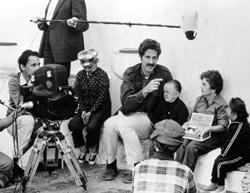 Herzog with his diminutive cast in Even Dwarfs Started Small.
Herzog with his diminutive cast in Even Dwarfs Started Small.
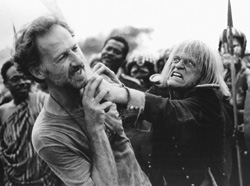 Klaus Kinski and Herzog typically discuss a scene in
Klaus Kinski and Herzog typically discuss a scene in
Aguirre: The Wrath of God.
Q: Did you cross paths with these filmmakers at festivals or in social circles?
A: Others met more among themselves, but I always felt estranged from my peers. Having been self-reliant from age 15 on, my life had been very different from theirs. With the student revolt in 1968, everyone was talking about liberating the working class. I asked, “Have you ever worked in a factory one day? One night? One hour?” No, none of them had. [They talked of liberating prisoners and] I asked, “Who of you has been incarcerated?” None. But I had seen prisons in Africa from the inside. They were just talking about a figment of their collective fantasy and had no idea. It's not that I would postulate that to be a filmmaker you have to first be a proletariat or go to jail, but you have to experience life. You need very naked, stark, fundamental experiences.
Q: It seems the Rogue Film School that you started this year focuses on such experiences, rather than the usual technical skills. What do you hope to accomplish with it?
A: I'm trying to keep it very condensed to a small group to better address their visions, dreams, perspectives and, in particular, the obstacles. How do you overcome obstacles? You have to be ready to do things that you would normally not do if you were in the insurance business or car repair. For example, I shot in Burma not long ago, after the monks' uprising. Of course you have the worst of all regimes there, so you just go and forge documents and shoot guerrilla style. You need a readiness to be utterly rogue and risk things.
Q: Your film school also has an unorthodox reading list.
A: I recommend four books for people who want to learn filmmaking in a rogue way, with a different spirit: Virgil's Georgics, Icelandic poetry from the 12th century, Hemingway's The Short Happy Life of Francis Macomber, and The True History of the Conquest of New Spain by Bernal Díaz del Castillo, who was a footman in the army of Cortés that conquered the Aztecs. He wrote an incredibly detailed account that is really storytelling at its best.
Q: So all of these books are important because of their storytelling?
A: No. I just want to make a point, to make it clear to those in my film school: read, read, read, read, read. For example, I went to Antarctica to make Encounters at the End of the World. You cannot go there and explore and scout. There are many times where you have only one shot. You are sent down and six weeks later you have to come back with a movie. I had no idea what I was going to see or whom I was going to encounter. My cinematographer, Peter Zeitlinger, asked, 'What are we going to do there? How do we get into this?' I had just read Virgil's Georgics again, and I said, 'We do it like Virgil.' Virgil, who was a farm boy growing up in Northern Italy, never explains; he just names the glory. I said to Zeitlinger, 'We do the same thing. We go down and name the glory of Antarctica. We do not need to explain. We find people there who are marvelous and we do not go into psychology. We just present them in all their wondrous attitudes and free spirit.'
Q: Is there any process you use every time you make a film?
A: There is no process. I see a film in front of my eyes as if I were sitting in a screening room. Because of that, I write screenplays very quickly, as fast as if I were copying one from a book. I hear the characters' dialogue, I see what they are doing, I hear the music. This is why I've never spent more than a few days writing a screenplay.
Q: You've also said that in preparing for your productions you don't use storyboards, correct?
A: Storyboards are for cowards, for those who lack imagination, for those who are bureaucratic and nothing else on the set. However, I cannot speak of that in absolute terms. When you're doing a film with real action or digital effects that depict fantastic landscapes, you have to organize the images so you don't run into trouble in post-production. So, for that type of film, I think storyboards are a legitimate, if not an indispensable, tool.
Q: You worked with the late Klaus Kinski five times, starting with Aguirre: The Wrath of God in 1972, in what had to be one of the most volatile relationships ever between an actor and a director. How did you handle his tirades?
A: I remember once he threw the most incredible tantrum because his coffee at breakfast was only lukewarm. [smiles] Every director has to find his or her own way to deal with complicated actors on the set. And it's not only actors. Sometimes you have crew members who create the complications. What always helps is if you have a very clear vision. People will fall into line in the wake of the dynamic you create.
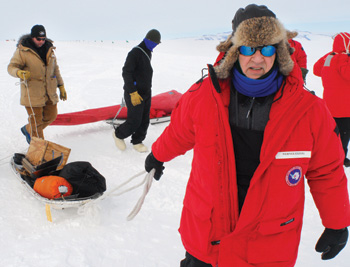 DO IT YOURSELF: Herzog went to Antarctica with a two-man crew to
DO IT YOURSELF: Herzog went to Antarctica with a two-man crew to
make Encounters at the End of the World.
Q: So no specific suggestions?
A: Oh, there is no advice. Maybe this: Fortify yourself with enough philosophy. That's one thing. Secondly, have a copy of Livy's The Second Punic War in your pocket at all times. And also the Bible. [After dealing with Kinski] I would go and read the book of Job for consolation.
Q: I know you like to shoot very quickly. Is it true you don't like to do more than a few takes?
A: Yes, but sometimes more, it depends. If something goes wrong technically, of course I will repeat and I have no problem with that. But if a scene doesn't work after four or five times, I get the suspicion that something—probably the text, or how the actors are instructed—is not right. So I'll take a quick, fresh look at things. I'll stop for 10 seconds, rewrite the dialogue in another 20 seconds, and just tell the actors what to say. All of a sudden, the scene will have life, it feels fresh, it has a dynamic. You have to have the nerve to look at what is happening on the set, a straight and direct look without checking into any video playback. I have never allowed a so-called 'video village' on my sets. I do not allow anyone to look at video playbacks on tiny little screens, except perhaps the cinematographer or his assistant who may need to check if the actors are in frame.
Q: What's the difference between a video playback and looking at dailies?
A: Well, dailies can also very often be misleading. But the good thing about dailies is that you get them on location maybe two or three days later. In many films I've done, I've never ever seen dailies. In Aguirre, my entire negative was lost. But you keep shooting. And that takes a lot of nerve.
Q: In Fitzcarraldo, two planes crashed, your leading actor got ill and had to be replaced, and your camp was destroyed in a border war between Peru and Ecuador. But what most people remember is the steamship you hauled over a mountaintop. Do you think that image will be your legacy?
A: No, no. For God's sake, I have made some 60 films by now and there are stronger films than that one. I'm a storyteller. Of course I care for images and I want to show things we have never seen or experienced or dreamt of. The image of a steamboat going over a mountain is very unusual and it drew a lot of attention. It's like a big metaphor, but don't ask me what the metaphor means, because I wouldn't know. Yet creating this image and showing it to an audience, all of us recognized something that has been dormant inside us and seems completely familiar, like finding a long-lost brother.
Q: With any other filmmaker today, an image like the steamboat climb would be generated through computer graphics. How do you feel about these changes in film technology?
A: Digital effects are a phenomenal invention, a phenomenal tool of human ingenuity that's fallen into our laps. And almost everything that is possible in our dreams and in our fantasies can be created now. However, it's not my way to do it. I can see that digital effects are increasingly not only to show certain mechanics of things like huge car crashes or whatever. All of a sudden, digital effects have understood there can be specific aesthetics to it. For example, the tumbling dinosaurs in King Kong that come down the ravine. It's just very, very beautiful, and it's more than just mechanics.
Q: What about shooting digitally?
A: We used the RED camera for My Son, My Son, What Have Ye Done. It's an immature camera created by computer people who do not have a sensibility or understanding for the value of high-precision mechanics, which has a 200-year history. It's terrible: Whenever you have to reboot the camera, it takes 4½ minutes or so. It drove me insane, because sometimes something is happening and you can't just push the button and record it. An assistant cameraman said this camera would be ideal if we were filming the National Library in Paris, which has been sitting there for centuries. But everything that moves faster than a library is a problem for the RED. Super 35 mm celluloid is still better.
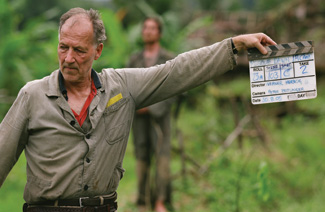 DO IT YOURSELF: The director calling the shots for a scene on Rescue Dawn.
DO IT YOURSELF: The director calling the shots for a scene on Rescue Dawn.
Q: Do you have a favorite camera?
A: If you need a workhorse for working in the mud, in the rain, in the jungle, I would grab an Arriflex. But it depends on what you are doing.
Q: What did you mean when you said many of your documentaries are feature films in disguise? Do you script your documentaries?
A: I stylize. I invent. Script sometimes, yes, sure. But not in order to cheat you. It is in order to give you moments of illumination, moments of a much deeper truth than just the factual existence there. And that's the stupidity of cinéma vérité, to trust too much in the facts…. In Death for Five Voices, a film I made about the 17th-century composer Carlo Gesualdo, almost everything is a poetic rendering and fantasy. Although it is very inventive, the film as a whole is the deepest insight into the composer that you'll find anywhere, the most truthful thing you will ever find on that man. It is only possible because almost everything is poetically invented.
Q: In La Soufrière, your documentary about a volcano about to erupt on a tiny Caribbean island, there's a fellow who refused to leave. I was wondering if his lines were scripted.
A: No, because you can tell when the camera is switched on he's still sleeping. I had the camera rolling and I walked up to him, and I started a discourse with him. After four or five minutes, he just got sick and tired of us. He was still lying on the ground, and finally he just sits up and looks at us and looks at the camera, and starts to sing a song just to get rid of us. You don't script a thing like that. Normally a situation like this has so much ecstasy of truth in it, so much poetry in it, you just don't invent it.
Q: You're not a major fan of technology, but what impact do you think new media is ultimately going to have on traditional filmmaking?
A: Everything is still in genesis. Everything is still boiling and changing and shifting. It will settle down somehow, and there will be wide, wide distribution of things through the Internet. But in my opinion, the mother of all battles has to be fought in the theaters. That's my postulate for my own films: If I do not reach the theaters, my work is in vain. When you're in a packed theater and everyone is laughing and enjoying what's on that big screen with that wonderful sound system, there's nothing beyond that. It's what I'm always aiming for. Everything else is secondary.
Q: What do you see as the biggest challenge facing filmmakers these days?
A: Well, of course there are several things, most obviously now being the financial crisis. This is why I took it upon myself with My Son, My Son, What Have Ye Done to make it on a fairly small budget with the best actors. Since I've produced some 40 of my own films, I know the value of money. For Bad Lieutenant, I demanded access to the budget on a daily basis. And each night after shooting I checked our cash flow, where we overspent, where we were precarious, where we had some cushion. In 60 films, I've never delivered one picture over budget. Five came in under budget and Bad Lieutenant was $2.6 million under. I do not shoot all sorts of angles and reversals and coverage. I shoot only what I need for the screen.
Q: You don't shoot any coverage?
A: I see the finished film in front of me. Other directors probably take a ritualistic approach, they don't know what they're doing and so they push their decisions into postproduction. It's okay, why not? But so many things are pushed further down the line, and there are many essentials—the rhythm of a film, the quality of acting, the focus on the wrong character—that you can't fix in postproduction. You'd better take charge on the set and do it right there.
Q: What about reshoots?
A: Never a reshoot. I've never had a reshoot in my life. It's not even in my dictionary. The word itself sounds odd to me.
Q: How does your frugality affect your cast and crew?
A: Hollywood has a tendency to throw five new crew members at everything that comes as a slight problem. So I say, 'No, stop! We have to sort things out. We have to be intelligent.' More people just makes everything clumsier. For example, on Bad Lieutenant, Eva Mendes asked for a fairly large entourage. I told her that I had waived my right to a trailer, a personal assistant, a chauffeur, even a director's chair. (The director's chair saved the production 65 bucks, but I despise them anyway and have never had one.) After all that, I told her, 'It would be nice if you wouldn't show up on my set with a psychiatrist for your dog.' She laughed so hard, and then, all of a sudden, she arrived with just a very essential makeup artist and a security guard. Actors know I want to take them where they have not been before and make them the best that they can be. I said to Eva, 'Nobody in my movies shows up on my set as a star. But whoever is on my screen, down to the smallest, shortest moment of an extra, will be treated like royalty.'
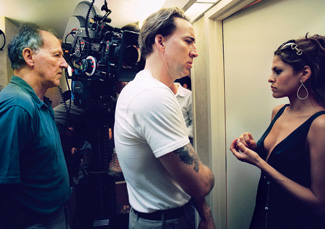 TOUGH ACT: "Every director has to find his or her own way to deal with complicated
TOUGH ACT: "Every director has to find his or her own way to deal with complicated
actors," says Herzog, with Nicolas Cage and Eva Mendes on Bad Lieutenant.
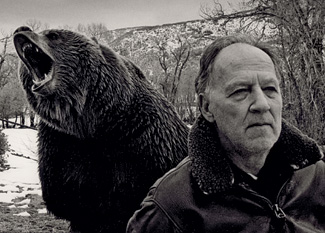 With the star of his DGA Award-winning documentary, Grizzly Man.
With the star of his DGA Award-winning documentary, Grizzly Man.
Q: How do you handle logistics on a big production?
A: On my sets, there's a hundred-foot perimeter from the camera in which walkie-talkies are not allowed. And within 200 feet of the camera there can be no cell phones. It takes all the focus away when everybody's chattering. I visited Forest Whitaker on the set of a film when we were in New Orleans. Dozens of people were hanging around a video village screen just 20 feet away from the actor, and somebody was whispering into a cell phone 30 feet away, right in his eye-line. I would have taken that man and sent him down the Mississippi on a raft. It's mind-boggling what is happening on these sets. I personally don't even own a cell phone.
Q: You seem very attuned to the sound of your films, whether it's the chirping of birds or classical music or the operas you use as a score. Do you have a theory about the use of sound?
A: I don't have a theory, but I'm very much aware of the value of sound. And while I am shooting, after a real good take is in the can, I always say, 'Freeze.' And the crew knows you don't move, you don't breathe, you don't even think, because it might register. And instantaneously I record the ambience for a minute or so. Whenever I hear something—a bird in the tree, or a creaking door somewhere, I immediately go with the soundman and we record it separately from close-up to use it later. So I create a whole cornucopia of ambiences and sounds and things.
Q: Do you loop much of your films' dialogue?
A: It depends. For example, in Aguirre: The Wrath of God, we were shooting next to rapids, and there was such a roar that we knew we'd have to loop it later. But normally, I like as clean as possible production sound. For My Son, My Son, What Have Ye Done, we filmed at a location not far from the San Diego airport, and every minute or so, a plane would take off. We had a lookout on a roof with binoculars who told us, 'If you do it now, you have 60 seconds.' We would film and 10 seconds after I called 'Cut!' the roar of a jet engine took over. So we were shooting in quick takes between departing airplanes. And it's absolutely clean.
Q: But generally, you're known for preferring long takes. Why is that?
A: If you shoot an entire scene in one take, by weaving in and out, and being close to what fascinates you, you create an inner flow of a scene, which is something an audience needs to weave itself into the rhythm of a film. The ideal thing is to do every single sequence in one shot. However, sometimes you have people too far apart or you are interested in how somebody reacts and you couldn't have a reaction if you followed just the main event of the scene.
Q: You said you're not a fan of digital cameras or computer graphics; what about your editing process?
A: Now that you can edit digitally, I can edit almost as fast as I'm thinking. What I do is watch all of the footage just once and, while it's running, I scribble notes in a logbook. If there's a wonderful moment 17 minutes and 20 seconds in on a tape, I'll quickly make two exclamation points in the margin. While watching and evaluating, I'll memorize 50 or 60 hours of footage—it sinks into my visual memory completely. Then we plow through it, and that's basically it. Grizzly Man took nine days to edit, the fine cut for Bad Lieutenant took two weeks, and My Son, My Son, What Have Ye Done was both shot and edited in five weeks. You have to add music and you always let it rest for a while, have another look at it and maybe throw out half a sequence or so, but the fine cut is finished very quickly.
Q: Rightfully or not, you're sometimes perceived as a wild man who shoots in far-off, dangerous locations. Is that a problem when you're casting your movies?
A: It's not my problem. It's the problem of the media, which sees me that way. Actors know that when I'm working it's like open-heart surgery: there's never a loud word. It's just going in for the essentials, quietly and professionally, and finishing the day of shooting by 2 or 4 p.m., on an average. I've never put an actor in any danger. It just has not happened. Whatever rumors are out there, I'm actually the quietest, most professional, and risk-averse director that you can find. In 60 films not one actor ever got hurt. Not one. So that's my track record.
Q: What about financing? Do you find it difficult to get insurance or completion bonds for your films?
A: No, I tell [producers] straight away I do not want a completion bond because it is a parasitical entity that only costs money. You know what is the completion guarantee? It's me, the director. I am the ultimate completion guarantee, because when I make a film, I deliver. And I deliver on time and on budget. I never need a completion bond.
Q: You've tried to make a film for years about Cortés, the Spanish explorer who brought down the Aztec empire. Is that still a dream project?
A: Since it's so expensive to recreate the ancient city of Tenochtitlan on a lake with palaces and pyramids and thousands of costumed extras, I've said that I'll make it after one of my films does more than $250 million at the domestic box office. Then all of a sudden, this film can be financed. I don't lose any sleep over it. You know, if you have a great story and the best actors, money will follow you like the common cur in the street with its tail between its legs.
Q: Are there any other projects you're pursuing at the moment?
A: Oh, I have five or six feature films pushing me. You see, it sounds as if I have a career and I'm planning a lot. But no, the films come like a home invasion, like burglars in the middle of the night. All of a sudden they are there, and you have to deal with them.
Q: Since Klaus Kinski died, you've worked with Nicolas Cage, Willem Dafoe and Christian Bale. Are there any other actors you want to direct?
A: Oh, Humphrey Bogart, I would love to work with him. Instantly. Give him to me.